A gurdwara or gurudwara is a place of assembly and worship for Sikhs. Sikhs also refer to gurdwaras as Gurdwara Sahib. People from all faiths are welcomed in gurdwaras. Each gurdwara has a Darbar Sahib where the Guru Granth Sahib is placed on a takhat in a prominent central position. Any congregant may recite, sing, and explain the verses from the Guru Granth Sahib, in the presence of the rest of the congregation.
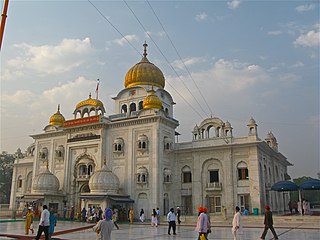
Gurdwara Bangla Sahib is one of the most prominent Sikh gurdwaras, or Sikh house of worship, in Delhi, India, and known for its association with the eighth Sikh Guru, Guru Har Krishan, as well as the holy pond inside its complex, known as the "Sarovar." It was first built as a small shrine by Sikh General Sardar Baghel Singh in 1783, on the bungalow donated by king Raja Jai Singh of Amer, who supervised the construction of nine Sikh shrines in Delhi in the same year, during the reign of Mughal Emperor, Shah Alam II.

The Damdamī Ṭaksāl, also sometimes referred to as Giani Samparda, Jatha Bhindra(n), or Sampardai Bhindra(n) is an orthodox Sikh cultural and educational organization, based in India. They are known for their teachings of vidya as well as gurbani santhya. Its headquarters are located in the town of Mehta Chowk, approximately 40 km north of the city of Amritsar. It has been described as a seminary or “moving university” of the Sikh countryside.
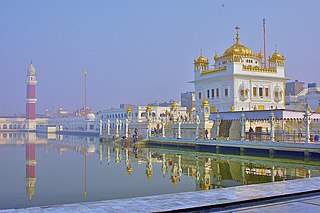
Tarn Taran Sahib is a city in the Majha region of the state of Punjab, in northern India. It is the district headquarters and hosts the municipal council of Tarn Taran district. Gurdwara Sri Tarn Taran Sahib, a prominent Sikh shrine is located in the central part of the city.

Anandpur Sahib, also referred simply as Anandpur, is a city in Rupnagar district (Ropar), on the edge of Shivalik Hills, in the Indian state of Punjab. Located near the Sutlej River, the city is one of the most sacred places in Sikhism, being the place where the last two Sikh Gurus, Guru Tegh Bahadur and Guru Gobind Singh, lived. It is also the place where Guru Gobind Singh founded the Khalsa Panth in 1699. The city is home to Takhat Sri Kesgarh Sahib, the third of the five Takhts in Sikhism.

The Gurdwara Rakab Ganj Sahib is a historic gurdwara near Parliament House in New Delhi. It was built in 1783, after Sikh military leader Baghel Singh (1730–1802) captured Delhi, on 11 March 1783, and his brief stay in Delhi, led to the construction of several Sikh religious shrines within the city. This one marks the site of cremation of the ninth Sikh Guru, Guru Tegh Bahadur, after his martyrdom in November 1675 for helping Kashmiri Hindu Pandits, under orders of the Islamic Mughal Emperor Aurangzeb. The Gurudwara Sahib is built near old Raisina village near Raisina Hill, at present Pandit Pant Marg, took 12 years to build. Prior to that, a mosque had been built near the spot.
Balachaur is a town in Balachaur Tehsil in the Shaheed Bhagat Singh Nagar District of Punjab, India.

Parivar Vichora is a Gurdwara situated on the bank of the river Sirsa in India. This is where the 10th Guru of Sikh, Guru Gobind SIngh Ji's, family got separated.
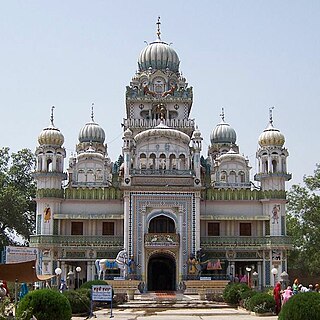
Gurdwara Mehdiana Sahib, also called the 'School of Sikh History' is a Sikh gurdwara located in the village of Mehdiana, just outside Mallha, near Jagraon in Ludhiana district, India.
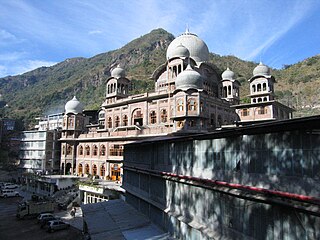
Baru Sahib also known as the "Valley of Divine Peace" is located in Himachal Pradesh, India.
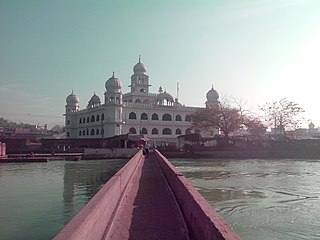
Kiratpur, also known as Kiratpur Sahib, is a town in Rupnagar district of Punjab, India. The town is the location of the Gurdwara Patal Puri where many Sikhs take ashes of their deceased.
Rara Sahib is a village near Ludhiana city in Punjab, India. This village was transformed from simple Rara to Rara Sahib due to the visit by the sixth Sikh Guru, Guru Hargobind Ji.
Bija or Beeja is a village and former princely state in the Punjab Hills, in District Ludhiana in India.

Hazur Sahib, also known as Takht Sachkhand Sri Hazur Abchalnagar Sahib, is one of the five takhts in Sikhism. The gurdwara was built between 1832 and 1837 by Maharaja Ranjit Singh (1780–1839). It is located on the banks of the Godavari River at the city of Nanded in the state of Maharashtra, India.
Lehal, now Patiala, was the famous village because of the visit by Sikhs' ninth Guru but now this village is a part of Patiala city.
Gurdwara Nagiana Sahib is a Gurudwara, or holy Sikh shrine, located in Udoke, a small village near Batala in Punjab, India. The shrine was built by the Sikh saint Sant Baba Chuggat Singh Ji, who served as the first official Sewadar (volunteer) of the shrine.
Ramgarh Sardaran is a village in Punjab state of India. It is situated 18 km from its tehsil Payal and approx. 40 km from its district ludhiana. As per 2014 stats, Ramgarh Sardaran village is also a gram panchayat.
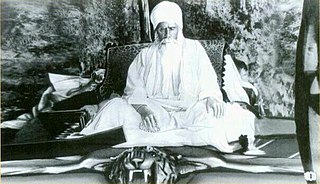
Sant Baba Nand Singh was a Sikh Saint. He is known as the founder of the Nanaksar Kaleran sampradya of Sikhism.
Akali Baba Joginder Singh Ji , better known as Baba Joginder Singh is a Nihang Singh and the 15th Jathedar of Budha Dal, after Akali Surjit Singh. He was born in Boparai Kalan, Ludhiana.












